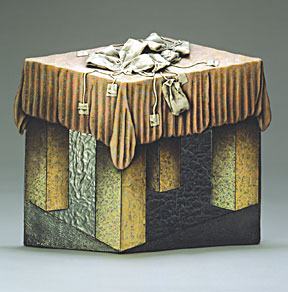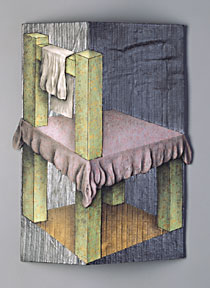|

COVER
STORY | IN THE NEWS | FROM THE PUBLISHER
ARTBEAT
| DIRT |
STAGE MATTERS | THE HUM | CALENDAR
February 23, 2006

Louis Marak's Ceramics:
Perspective and Retrospective
by
KATHERINE ALMY
 It's
the end of an era at the HSU Ceramics Department -- Louis Marak
is retiring after 37 years of teaching. He came here from upstate
New York in 1969, interested in what was going on with West Coast
ceramics. He had landed the job after an interview at a College
Art Association conference, but the school's budget didn't cover
a trip to come and check the place out. So Lou and his wife,
Noelle, moved to Humboldt County sight unseen. They haven't regretted
the decision. It's
the end of an era at the HSU Ceramics Department -- Louis Marak
is retiring after 37 years of teaching. He came here from upstate
New York in 1969, interested in what was going on with West Coast
ceramics. He had landed the job after an interview at a College
Art Association conference, but the school's budget didn't cover
a trip to come and check the place out. So Lou and his wife,
Noelle, moved to Humboldt County sight unseen. They haven't regretted
the decision.
Soon after he started at Humboldt, the college
acquired a building, an old laundry, which was converted into
a makeshift ceramics studio. He was originally told that it would
be a temporary thing, so there wouldn't be a lot of expensive
alterations. Thirty-odd years later, the pottery lab is still
there and any improvements have been made by the staff and the
students. Be that as it may, it must have been exciting to be
involved in setting up a whole new studio.
Right: "Tea Bag Table," 1991
Throughout his teaching career, Lou has also worked
on his own art, producing and selling pieces, exhibiting nationally
and internationally, winning awards and conducting workshops
throughout the country. He's been a busy guy.
In honor of his retirement, HSU's First Street
Gallery is presenting a retrospective. The exhibit spans his
career and features "new works, works never seen before
and works borrowed from lenders throughout the West." They
also produced a gorgeous exhibition catalog with photos by Robin
Robin, an essay by Jo Lauria (an independent curator and museum
consultant) and a student appreciation written by Pauline Greenfield,
an intern at the gallery. Perusing the show and savoring the
catalog will give you a good sense of Lou's development as an
artist. So I don't really need to write anything more. But I
will, because I love to put in my own two cents.
Lou is known for his sculptural optical illusions.
He employs what arty folks call trompe l'oeil, which translates
roughly to "fool the eye." Technically, all realistic
painting on canvas employs trompe l'oeil. After all, you've
got a two-dimensional (2D) surface and you're fooling the viewer
into believing that they are looking at a real, fully dimensional
landscape, still life or person. There are various techniques
(besides carefully rendering what you see) that an artist can
use to aid the deception. One of them is linear perspective,
which was "discovered" in the 15th century. It was
discovered like gravity was discovered -- it always existed,
but someone had to figure out what it was and take notes. Like
most things, it was a long process and many people contributed
to the theory, but its "discovery" is generally credited
to Filippo Brunelleschi, a sculptor and architect who took really
good notes.
Basically, a good understanding of linear perspective
helps you recreate on paper the shapes that three-dimensional
(3D) objects have in space. That and some good shading will do
a lot to give a flat surface depth. So getting back to Lou Marak's
work, here's a guy who works with a 3D surface. So what does
he do? He flattens the object and uses perspective to pretend
that it's deep again. Why, you may ask? Because he can, and because
he likes to play around with things and make you ask questions.
 Lou's
work involves drawing, painting and sculpting -- all mediums
that he enjoys. The pieces are built with clay, but they start
as drawings and the surfaces are painted. While the pieces are
sculptural, the 2D surfaces of the pieces are as important as
the 3D elements. A sculptural tail that sticks up out of the
top of a vase will complete a fish that is painted on the surface
of the vase. The 2D surfaces are also where he puts that perspective
to use, making a shallow surface look like a full-sized table
or chair. He uses low relief for elements like water drips, furled
tablecloths and tea bags. Tea bags? Yes, the Tea Bag Table is
a low table draped with a cloth and piled with used tea bags.
Don't look too deeply for the significance of the tea bag --
the artist probably just drinks a lot of tea. Lou's
work involves drawing, painting and sculpting -- all mediums
that he enjoys. The pieces are built with clay, but they start
as drawings and the surfaces are painted. While the pieces are
sculptural, the 2D surfaces of the pieces are as important as
the 3D elements. A sculptural tail that sticks up out of the
top of a vase will complete a fish that is painted on the surface
of the vase. The 2D surfaces are also where he puts that perspective
to use, making a shallow surface look like a full-sized table
or chair. He uses low relief for elements like water drips, furled
tablecloths and tea bags. Tea bags? Yes, the Tea Bag Table is
a low table draped with a cloth and piled with used tea bags.
Don't look too deeply for the significance of the tea bag --
the artist probably just drinks a lot of tea.
Left: "Green Chair," 1985
And speaking of deeper meanings, that's not the
point for Lou. You'll find various motifs that show up a lot
in his work: hands, water, fish. But you can't get him to pontificate
on them. He just likes working with them and the way they look.
He likes to juxtapose elements in illogical ways, to play with
perspective and illusion and, as he writes in his artist's statement,
to "pose questions rather than provide answers."
All of this trickery makes for sculptures that
are fun to look at, and, indeed, humor is a big part of Lou's
work. But in addition to that, and despite my light-hearted discussion
of his work, his technical skill is vast and impressive. Many
of the techniques he employs he developed himself, and his work
is precise, detailed and flawless. Those who collect his art
enjoy the wry humor of it; fellow ceramic artists are in awe
of his skill.
The HSU ceramics studio is going to be a different
place without Lou. I spoke with Keith Schneider, one of Lou's
colleagues, about his leaving. "He was the man!" Keith
says -- popular with students and faculty, in love with his medium
and able to translate his enthusiasm to his students. He also
put in a lot of overtime, working with students outside of class.
His own successful artwork, exhibitions and sales set a good
example to students of a working artist.
But I sincerely doubt that Lou is going to fade
away. He'll keep working and with the extra time he can devote
to his art, we can probably expect to see wild new developments
in his sculptures. So here's to a successful teaching career
and an unknown but promising future.
Louis Marak: A Retrospective, 1963-2006 is on
exhibit at HSU's First Street Gallery, 422 First St., Eureka.
Gallery hours are Tuesday-Sunday, noon-5 p.m. 443-6363 for further
details.



Got a local exhibit or art event
that might make a good story? Send your art news to almy@arcatanet.com
or write in care of the North
Coast Journal, 145 South G Street, Suite A, Arcata, CA. 95521.
COVER
STORY | IN THE NEWS | FROM THE PUBLISHER
ARTBEAT
| DIRT |
STAGE MATTERS | THE HUM | CALENDAR
Comments? Write
a letter!

© Copyright 2006, North Coast Journal,
Inc.
|